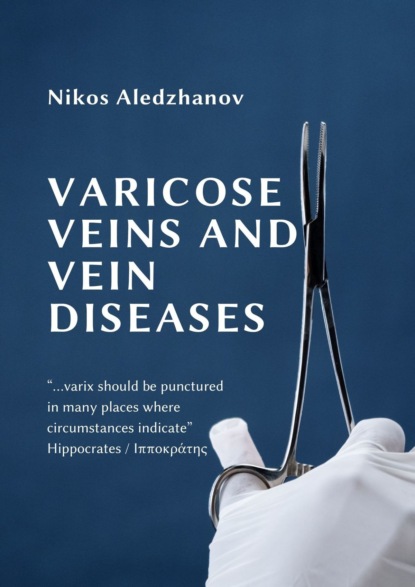По всем вопросам обращайтесь на: info@litportal.ru
(©) 2003-2024.
✖
VARICOSE VEINS AND VEIN DISEASES
Настройки чтения
Размер шрифта
Высота строк
Поля
What are the symptoms of venous diseases and when to consult a phlebologist?
When the following symptoms appear: spider veins and meshes, the appearance of varicose veins, ooedema, sudden one-sided ooedema (urgently), redness of the skin along the veins, heaviness or pain in the legs, the appearance of pigmentation on the skin of the legs, trophic changes, ulcers, during pregnancy for the prevention or treatment (varicose veins, thrombosis) and others.
What are the diagnoses for venous diseases, what is written in the doctor’s conclusion?
Chronic venous disease is diagnosed according to the CEAP classification.
CEAP is a clinical, etiological, anatomopathophysiological classification that takes into account: clinical manifestations (C – clinic), etiology (E – etiology), anatomical localization (A – anatomy) and pathogenesis (P – pathogenesis) of the disease. The reason for attributing a patient to a particular class is the presence of the most pronounced objective symptom of chronic venous diseases.
Examples of diagnoses:
CEAP: C2, S, Ep, As, p, Pr, 2.18 denotes: Symptomatic varicose veins, primary disease. Reflux along the great saphenous vein in the thigh and the perforating vein of the lower leg.
CEAP: C 3, S, Es, Ad, Po, 11,13,14,15 means: Post-thrombotic disease of the lower limb veins with oedema. Deep vein obstruction of the femoral-popliteal segment and tibial veins of the lower leg.
Interesting fact.
In 400 BC, Hippocrates first described varicose veins and how to treat it.
Chapter III
Vein Diseases
“Everything that the doctor does, let him do it right and beautifully”
Hippocrates / Ιπποκράτης
This chapter details common vein diseases and their complications.
Spider veins and meshes
Varicose veins
Thrombosis
Chronic venous insufficiency
Trophik disorders
Spider veins and meshes
Telangiectasia is a persistent expansion of small vessels of the skin (arterioles, venules, capillaries) of a non-inflammatory nature, showing by spider veins or reticules. The word comes from the Greek “expansion of the final part of the vessel”, telos (τέλος) – end, segment, and ectasia – expansion. Spider veins develop in the skin veins and give only a cosmetic defect when they are dilated and not harmful to health and this is not varicosity, but they can also be combined with varicose veins. “Meshes” and “spider veins” in medical terminology are called reticular veins and telangiectasias which is a very common pathology.
What are the reasons?
There are no proven reasons for their occurrence. There are several theories, for example, changes in hormonal levels (during pregnancy) or taking contraceptives, but all of them have not been proven.
Spider veins are varicose veins?
They do not cause a health hazard, complications and varicosity.
How to find out if there are meshes and spider veins or not?
One of the main reasons for seeking medical attention is cosmetic. This phenomenon is common to all ages. Eventually, the number of meshes increases. In older age, they form on the skin of the legs and legs but they do not go into varicosity.
Which doctor you need to contact?
Phlebologists and cosmetologists deal with the treatment of meshes and spider veins. However, it is best to contact a phlebologist, since doctor has experience in treatment and diagnosis, phlebologist can diagnose concomitant pathology if it is present, for example, varicose veins, and start treatment at an early stage, and as the third argument is that if a cosmetologists detects a disease, you go again to the phlebologist.
The treatment
This pathology is treated to remove unwanted cosmetic defects from the skin.
There are several treatments, the most popular of which are microsclerotherapy, laser percutaneous coagulation, radiofrequency coagulation and the ClaCS method. These methods are practically uncomplicated.
Microsclerotherapy is the introduction into a vessel of a special substance (sclerosant), which leads to the “sticking” of small vessels.
Laser percutaneous coagulation is a laser of a certain wavelength on the vessels, which allows them to be hardened without damaging the skin.
Radiofrequency coagulation – electrocoagulation.
However, in practice, microsclerotherapy and laser percutaneous coagulation are mainly used.
ClaCS method is a combined method of phlebologist Kazu Miyaki.
CLaCS is a method for the treatment of spider veins and asterisks. It combines the techniques of sclerotherapy (concentrated 70% glucose) and laser percutaneous removal with cooling during the procedure. The procedure is outpatient and takes about an hour. There are no advantages of some methods over others in the treatment of nets and asterisks.
Complications of the treatment
Complications are possible after any of the treatment methods for this pathology. Skin pigmentation, skin necrosis, relapse and allergic reactions.
– Hyperpigmentation and depigmentation
After the procedures, brown spots are formed. Hyperpigmentation will go away within a few months or years but depigmentation is rareand the causes of these complications are unknown.
– Skin necrosis
It is not common complication. The complication is associated with the wrong technique of performing the procedure. As a result, either heals completely, or leaves a small scar.
– Relapse
The appearance of new telangiectasias, most of which later go away on their own.
– Allergic reactions
As with the vast majority of drugs, the body may react to sclerosants. Modern sclerotherapy drugs are not strong allergens, and allergic reactions are rare.
Prevention





